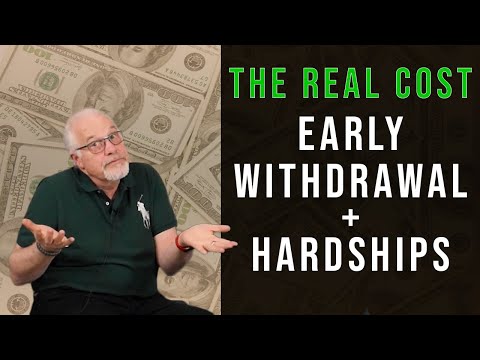Understanding 401k Hardship Withdrawal in Today’s Financial Landscape
In a world where the only constant is change, the way we handle our finances, especially when it comes to retirement planning, must be agile. With the unpredictable nature of life’s financial demands, the 401k hardship withdrawal has become an instrument some individuals see as a financial escape hatch. But what’s the real deal with it?

The Truth Behind the 401k Hardship Withdrawal Process
The concept of a 401k hardship withdrawal might seem straightforward: you dip into your retirement funds early due to immediate and heavy financial needs. These needs can include significant expenses such as medical bills, funeral costs, or tuition. But there’s more than meets the eye:

Navigating the Nuances of 401k Hardship Loans
That’s right, 401k hardship loans are a different beast altogether. While a hardship loan from your 401k is meant to be paid back—often with interest—a withdrawal is a one-way transaction. Here’s the lowdown:
The New 401k Hardship Withdrawal Rules of 2023: What Has Changed?
Rules are always evolving, and the new 401k hardship withdrawal rules 2023 are no exception. The modifications could change your game plan:
The 5 Shocking Facts About 401k Hardship Withdrawals
Fact 1: The Surprising Tax Implications
One might think pulling money from your 401k is just a matter of solving an immediate need, yet the taxman still awaits:
Fact 2: The Long-Term Effects on Retirement Savings
Imagine a future you, looking back with gratitude or regret:
Fact 3: The Reality of Repayment Expectations
This isn’t an “IOU” situation:
Fact 4: The Unseen Hurdles in the Application Process
Getting your hands on those funds isn’t as easy as saying “please”:
Fact 5: The Overlooked Alternatives to Withdrawing from Your 401k
There’s more than one way to peel an orange, as they say:
Strategizing Financial Decisions Beyond 401k Hardship Withdrawals
Financial planning is about strategy, not just tactics. A 401k hardship withdrawal should be a last resort:
![401k Hardship Withdrawals [What You Need To Know]](https://www.mortgagerater.com/wp-content/cache/flying-press/AJ0gxuqu6Lw-hqdefault.jpg)
Rethinking Your Approach to 401k Hardship Withdrawals
Let’s circle back and harvest the key insights:

| **Aspect** | **Details** |
|---|---|
| Purpose of Withdrawal | Allowed for “immediate and heavy financial need” such as: medical expenses, funeral expenses, tuition, educational expenses for account holder, spouse, dependents, or beneficiary. |
| Evidence of Hardship | Requirements include documentation like medical bills, eviction notice, or funeral expenses to prove the financial need. |
| Tax Implications | Withdrawals are subject to income taxes; may also incur a 10% early withdrawal penalty if taken before age 59½ unless exceptions apply (e.g., CARES Act provisions). |
| Penalty Exceptions | CARES Act allowed up to $100,000 in distributions without the 10% penalty (as of 2020). Some exceptions may still apply based on evolving legislation. |
| Repayment | Unlike 401(k) loans, hardship withdrawals do not need to be paid back to the 401(k) account. |
| Plan Requirement | Each employer’s 401(k) plan may have different rules regarding hardship withdrawals. Not all plans permit them. |
| Application Process | Contact employer or plan administrator for the withdrawal process. Provide required documentation to prove hardship. |
| Processing Time | Receiving funds may take 7-10 business days via USPS mail for checks or 2-3 business days via direct deposit/ACH. |
| Legal & Ethical Considerations | Lying to get a 401(k) hardship withdrawal can result in legal repercussions (fraud), financial penalties, and additional taxes. |
| Loan vs. Withdrawal | A 401(k) hardship withdrawal is not a loan and hence is not repaid. Contrasts with a 401(k) loan, which must be repaid with interest. |
| Access To Funds | Hardship withdrawals are typically limited to the amount necessary to satisfy the financial need. |
Conclusion: Planning Ahead to Avoid Pension Panics
We’re wrapping up, but your financial journey is ongoing, and it’s paved with many options:

Your 401k is meant to be a cornerstone of your retirement. Think twice, plan thrice, and act wisely before considering a 401k hardship withdrawal. Remember, when it comes to your financial life, playing the long game is more Beyoncé’s epic concert in Dubai than a split-second guess on The Ultimatum. And when you’re strategizing for your financial future, consider all the tools in your belt – from Navigating 401k hardship Withdrawals to learning about The nitty-gritty Of borrowing From Your 401k. Protecting your retirement savings will have you on track to financial freedom, ensuring the next chapters of your life’s story are as vibrant and secure as you envision them today.
The Ins and Outs of a 401k Hardship Withdrawal
When life throws you a curveball, a 401k hardship withdrawal might seem like the knight in shining armor coming to your financial rescue. But hold your horses, because there’s a whole lot about this emergency escape hatch that might just shock you. Let’s dive into the good, the bad, and the downright surprising!
It’s Not a Get-Out-of-Jail-Free Card
First things first, a 401k hardship withdrawal isn’t some magic trick like pulling a rabbit out of a hat. No siree, it’s more like pulling a thorn out of your side; it can hurt and leaves a mark. You see, taking money out of your 401k before you retire is like saying goodbye to your hard-earned cash. Just like realizing Tyler the Creator’s personal life twist, it can leave you saying, “Whoa, didn’t see that coming!
Proving Your Hardship Is Tougher Than You’d Think
Ever heard of Brandi Worley? Her shocking tale is as tragic and convoluted as proving you’ve got a legit hardship that qualifies for a 401k withdrawal. It’s not enough to just feel the pinch; you’ve got to prove to your plan administrator that you’re truly up against the wall, with expenses like medical bills, funeral costs, or preventing eviction. It’s like telling a skeptic you saw a unicorn; you better have some solid evidence.
The Sneaky Penalties Will Creep Up on You
Ah, penalties, the unwanted stowaway in your financial journey. When you take a 401k hardship withdrawal, they can pop out like an AirTag in a lost wallet, reminding you that everything comes with a price. You might have to pay a 10% early withdrawal penalty plus taxes on that money. It’s like going to a Beyonce Dubai concert, having the time of your life, and then facing the music when you realize you’ve blown your budget.
The IRS Is Watching You… Closely
Think of the IRS as the chaperone at your high school dance. They’re not just there for decoration; they’re keeping an eye on every move you make, especially when it comes to a 401k hardship withdrawal. Expect them to lean in real close and scrutinize every detail because buddy, they want to ensure every T is crossed and I is dotted.
Your Future Self Might Not Thank You
Taking money from your 401k can feel like borrowing from an open-minded friend, but remember, this friend is your future self. And guess what? They’re counting on that money for retirement. So, consider the consequences; although it might relieve your current pinch, it can lead to a “future me problem.”
There you have it, folks! A 401k hardship withdrawal might seem like a lifeline, but it’s packed with surprises that can make you think twice. So, before you dive into your retirement savings like a starving kid at a candy store, make sure it’s absolutely necessary and that you’re ready for the potential fallout. Your future self will thank you!

What qualifies for hardship withdrawal from 401k?
Qualifying for a hardship withdrawal from a 401k isn’t just a walk in the park, folks. You need to show an immediate and heavy financial need that dips into certain categories – things like medical expenses, home purchase costs, tuition fees, eviction avoidance, burial costs, or repair damage to your home after a natural disaster. Just remember, these withdrawals are pretty strict, so it’s not about wanting a fancy new car but about those unexpected life curveballs.
What is considered a hardship situation?
A hardship situation is when you’re up a creek without a paddle, financially speaking. It’s those moments when you’re facing serious money woes, like medical bills that climb higher than a skyscraper, eviction notices, funeral expenses, or hefty costs for fixing your house after Mother Nature goes wild. To cut through the jargon, it’s when life throws you a serious lemon and expects you to make lemonade — without sugar.
What is a qualifying financial hardship?
Qualifying financial hardship is like officially admitting you’re in a tight spot. It’s when you’re in a money pickle, like knee-deep in medical bills, staring at a college tuition bill that’s through the roof, or your roof literally needs fixing after a brutal storm. It’s the kind of squeeze where you need cash pronto, and it’s not for splurging on a luxury splurge but for footing the essential expenses.
Can I lie to get a hardship withdrawal from 401k?
Holy smokes, don’t even think about fibbing to snag a hardship withdrawal from your 401k! That’s like playing with fire, and you’ll likely get burned. Besides, honesty is the best policy, right? The IRS isn’t known for being gullible, and if they catch your pants on fire (figuratively, of course), you’ll be in a world of hurt with penalties and possibly even tax fraud charges. So, let’s stick to the straight and narrow, shall we?
What proof do you need for a hardship withdrawal?
Yeah, they’re gonna want proof for your hardship withdrawal — no ifs, ands, or buts. You’ve gotta roll up your sleeves and dig up those documents that show you’re not just crying wolf. We’re talking bills, invoices, notices, and all that jazz that makes the IRS nod, saying, “Yeah, you really do need this money.” It’s like showing your homework to prove you didn’t just copy it from your buddy.
Do I need to show proof for hardship withdrawal?
Absolutely, showing proof for a hardship withdrawal is a must. It’s pretty much like you’ve gotta put your money where your mouth is. The IRS isn’t going to just take your word for it — they want to see the nitty-gritty, the paper trail that proves you’re really in a bind. It’s like showing your mom the broken vase before she believes you didn’t just eat cookies for dinner.
Can you be denied a hardship withdrawal?
Sure can, buddy. Just because you ask for a hardship withdrawal doesn’t mean it’s a done deal. If the powers-that-be think your situation doesn’t quite meet the criteria, or you don’t have enough evidence to back up your story, they might just say “no dice.” It’s like going for a touchdown and fumbling the ball at the one-yard line — so close yet so far.
What are the five common categories of hardship?
The five common categories of hardship? Let me paint you a picture: medical drama, home sweet home purchase costs, college craziness, avoiding getting the boot from your pad (a.k.a. eviction), and finally, when the death reaper calls, covering funeral costs. Imagine this rogue’s gallery of expenses just waltzing into your life and you’ve gotta deal with ’em pronto.
What are common hardships?
Common hardships are like those unexpected guests that show up at your doorstep and refuse to leave — think monstrous medical bills, college fees that make your eyes pop, or a home disaster that has left you shaking your head. It’s these tough cookies that qualify as true hardships, the ones that have you scratching your head wondering how you’re gonna cover them with whatever’s left in your piggy bank.
Can credit card debt be considered a hardship?
Credit card debt sitting in your lap like an unwelcome houseguest can indeed be a hardship, but not always the kind that opens the door to a 401k hardship withdrawal. It’s typically not on the VIP list unless it’s tied to one of those big-ticket requirements like avoiding eviction or a foreclosure. In the end, the IRS is kinda like the bouncer deciding who gets into the club.
What happens if you lie about hardship withdrawal?
If you lie about a hardship withdrawal, you’re basically poking the bear, and in this case, the bear is the IRS. They don’t take kindly to being hoodwinked. If you get caught, it’s like opening Pandora’s box of tax penalties, extra taxes, and you might even get a starring role in your very own tax fraud saga. Talk about a series of unfortunate events!
Can I withdraw from 401k in 2023 hardship?
Withdraw from a 401k for hardships in 2023? You bet, it’s still on the table. But before you dive in, cross your T’s and dot your I’s; make sure you’re operating within the IRS rules. It’s like playing by the house rules in a friendly game of Monopoly — no one likes a cheater, and Uncle Sam is a heck of a stickler when he’s overseeing the game.
Why would a hardship withdrawal get denied?
Why would a hardship withdrawal get denied? Well, sometimes the story just doesn’t add up or your proof is as thin as ice in spring. If the IRS peeks over your shoulder and decides you’re trying to pull a fast one or that your situation doesn’t fit the bill, they’ll drop the denial hammer faster than you can say “but I really need it!”
Why would a hardship withdrawal be denied?
A hardship withdrawal might be given the thumbs down if it smells fishy — like your reasons are weaker than a cup of gas station coffee or your paperwork isn’t convincing. It’s no secret, the IRS can sniff out a bluff from a mile away. So, if you can’t show clear-cut evidence that you’re up against the ropes, they’ll shut the door on your hardship claim.
Can I use my 401k to pay off debt?
Can you dip into your 401k to pay off debt? Sure, you can consider it, but it’s kind of like using a sledgehammer to crack a nut — drastic and maybe not the smartest move. There could be penalties and taxes adding insult to injury, so you wanna weigh that option like a judge at a pie-eating contest before letting loose with your retirement funds.
What reasons can you withdraw from 401k without penalty?
Reasons you can yank cash from your 401k without getting slapped with a penalty? Sure, there are a few golden tickets — we’re talking heavy-duty hardships like covering medical bill mountains, dishing out dough for a down payment on your main pad, or college fees that make your wallet cry. And don’t forget if you’re 59½ or laid off at 55 or older, you might get a green light. Just be sure to check the latest rules so you don’t step on any legal landmines.
Do hardship withdrawals get denied?
Do hardship withdrawals get denied? Just like rain on your parade, yep, they can. If your ducks aren’t in a row, and by ducks, I mean ‘proof of a financial pickle,’ the folks holding the purse strings can give you the cold shoulder. Make sure your hardship hardship sings true, or it’s like inviting the IRS to a game of ‘Gotcha!’
What are the safe harbor reasons for a hardship withdrawal?
The safe harbor reasons for a hardship withdrawal are like your emergency toolkit when disaster strikes. We’re talking crucial costs like hefty medical bills, buying your main house, tuition fees that are through the roof, payments to avoid eviction or foreclosure, funeral expenses, or getting your home back to snuff after a casualty loss. These are your ticket to potentially cracking open that 401k piggy bank – so long as you keep it by the book!



